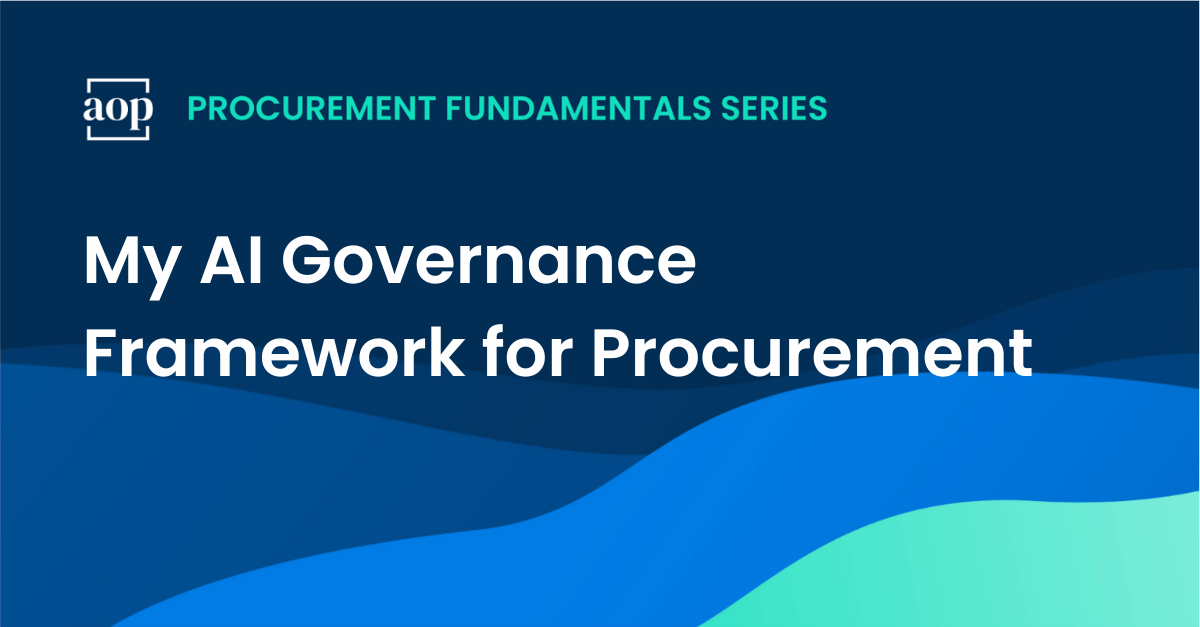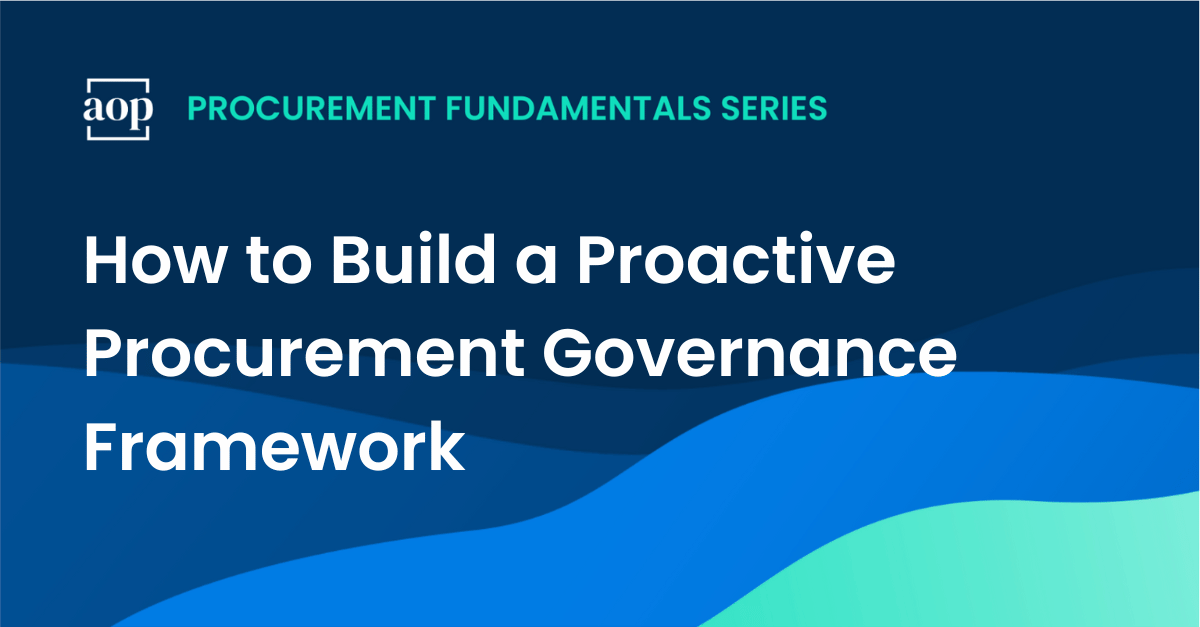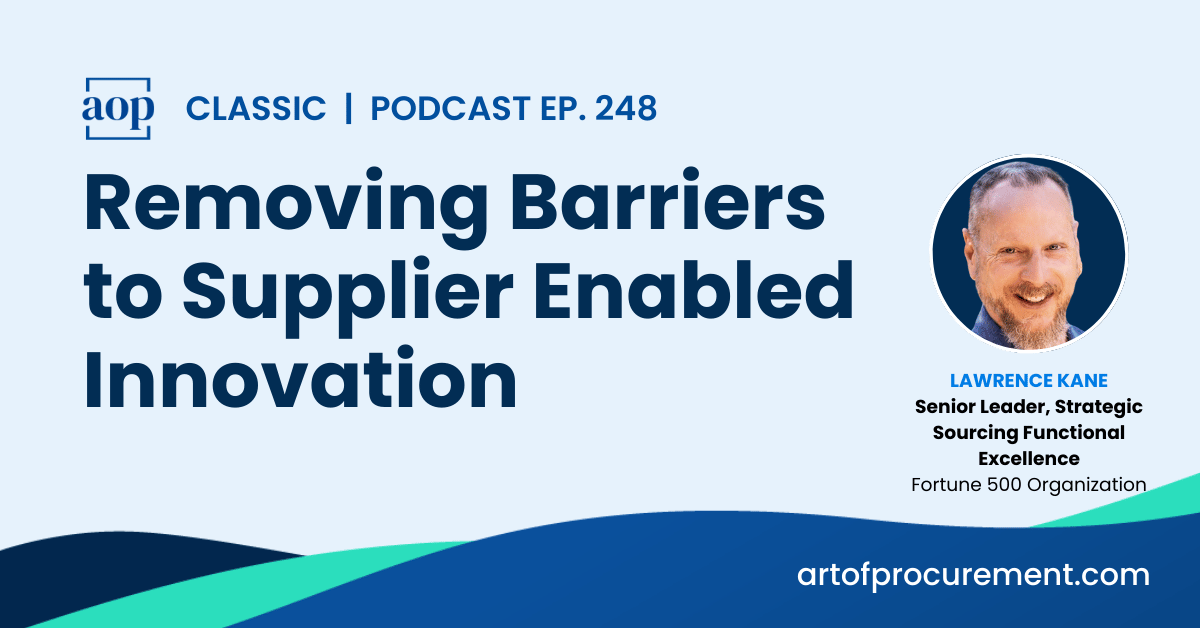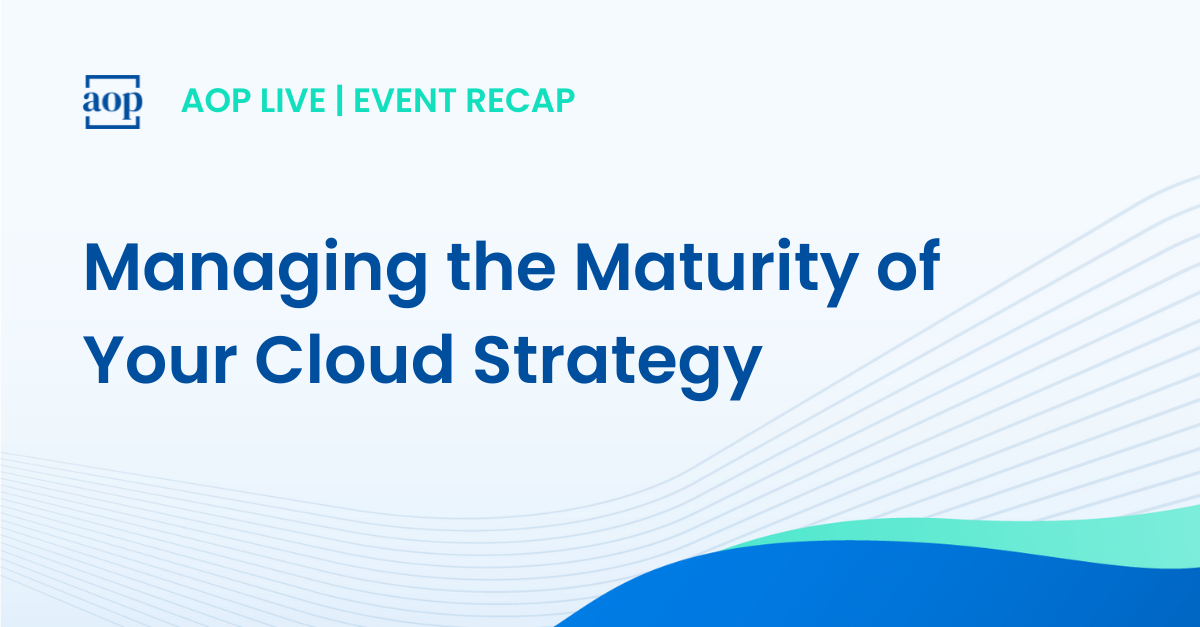
Most procurement teams are racing to integrate AI into their processes - from sourcing and contracts to spend analytics. This promises huge efficiency gains, but it also introduces new risks and responsibilities.
To capture AI's benefits without sacrificing trust or control, establish a comprehensive AI governance framework. Such a framework sets clear principles—accountability, transparency, fairness, risk management, and data governance—and tailors them to procurement's unique activities.
This blueprint combines proven governance practices with practical insights from experts interviewed by Art of Procurement. Our goal is to help you maximize AI's value while not exposing the business to unnecessary risk.
Why you need AI governance
AI is no longer a novelty in procurement – it’s fast becoming business-as-usual. 94 percent of procurement teams now leverage generative AI tools (up from just 50 percent in 2023).
Organizations deploy AI for everything from analyzing spend data to automating supplier communications. This transformation can yield tremendous improvements in speed and decision-making. However, transformation can also introduce risk and demand greater due diligence when selecting or using AI solutions.
Your role in shaping AI governance
Procurement operates at the intersection of many sensitive domains (finance, legal, supply chain), so unchecked AI could lead to compliance violations, biased decisions, or reputational damage. In fact, fewer than one-third of large enterprises permit unrestricted AI use due to concerns around data security and compliance, making governance and regulatory adherence a top priority for procurement leaders.
Leading companies recognize that AI governance balances innovation with control. For procurement, this means establishing guardrails around AI deployments—policies, oversight processes, and ethical guidelines—to ensure AI-driven processes meet corporate governance and regulatory requirements. Be as strategic about governing AI as you are about adopting it.
Accountability in AI decision-making
Accountability forms the cornerstone of AI governance. It ensures there are clear owners for any AI outputs and outcomes. In procurement, this principle means that human leaders remain responsible for decisions and results, even when AI tools are involved. For example, if an AI-driven supplier scoring system recommends a new supplier, a designated procurement professional (or committee) should be accountable for reviewing that recommendation before acting on it. Eliminate "black box" excuses; when something goes wrong with AI, your process should address issues and assign responsibility.
Practical ways to establish accountability
In practice, establish accountability by creating specific roles or oversight bodies. Many enterprises form AI ethics boards or governance committees that include procurement, IT, legal, and risk executives. These groups set policies and review major AI initiatives.
Define clear roles and escalation paths for AI-related decisions within your team. For instance, require your CPO or a designated "AI champion" to sign off on any AI that negotiates contracts or selects suppliers.
According to IBM, 80 percent of organizations now have part of their risk function dedicated to AI – a sign that enterprises are formalizing accountability for AI at senior levels. Foster a culture where every leader prioritizes accountability and ensures responsible AI use across the organization.
Transparency and explainability in AI systems
Transparency is vital to building trust in AI-driven procurement processes. It means procurement teams (and their stakeholders) should be able to understand how an AI tool is arriving at its outputs or recommendations.
AI should be explainable rather than a mysterious source of answers. For instance, if an AI tool flags certain suppliers as high-risk, the team needs visibility into the factors or data that led to that conclusion. This is not only good practice but often necessary to comply with regulations and internal audit requirements. The OECD’s principles for trustworthy AI (endorsed by 40+ countries) include transparency alongside fairness and accountability as core requirements.
Examples of explainable AI in procurement
In procurement, explainability might involve choosing AI solutions that can provide audit logs or rationale for their decisions. If a spend analysis AI reclassifies a batch of expenses, it should indicate why (e.g. patterns learned from historical data). If a contract review AI suggests changing a clause, it should highlight the risky language it identified.
Procurement leaders should demand this level of clarity from AI providers and incorporate it into contracts (e.g. requiring access to model documentation or outputs for review). Internally, procurement teams should document where and how AI is used in their workflows. This could mean maintaining an inventory of AI applications with details on their purpose, data inputs, and decision logic.
Transparency in communications
Open communication with stakeholders is also key. Be prepared to explain to business units, suppliers, or auditors how an AI-assisted decision was reached. By making AI processes transparent and clearly sharing how models work, you foster trust and reduce fear of the unknown. Transparency transforms AI from a magic box into a well-understood tool that everyone can trust.
Fairness and ethical AI use in procurement
The principle of fairness ensures that AI in procurement operates without bias and does not inadvertently discriminate or create unethical outcomes. Procurement functions have a direct impact on suppliers and stakeholders, so fairness is both a moral and a business imperative – biased or unethical AI decisions could lead to legal challenges or damage important relationships.
An AI governance framework should explicitly include ethical guidelines and fairness checks for any AI used in sourcing, supplier evaluation, or other areas. In practice, this means procurement teams need to be vigilant about the data and algorithms behind their AI tools.
Factor in bias in data and supplier relationships
One risk is that AI systems could reflect historical biases present in data. For example, if past sourcing decisions favored certain geographies or incumbent suppliers, an AI trained on that data might unfairly screen out newer or diverse suppliers. To counter this, procurement should ensure diverse, representative data is used and consider setting rules in AI tools (e.g. always include a mix of incumbent and new suppliers in recommendations).
Apply fairness to how you implement AI decisions. Even if AI flags a supplier as high-risk, give that supplier an opportunity to respond or correct information rather than immediately severing ties. Keep human judgment in the loop to ensure equity.
Develop an ethical AI checklist covering questions like: Does this AI decision treat all suppliers and stakeholders fairly? Have we considered potential unintended impacts or biases? If the answers are uncertain, make adjustments or overrides. Embedding fairness considerations into your AI governance mitigates risk and supports broader ESG and diversity goals.
Risk management and compliance controls
Procurement organizations understand risk management – and AI introduces a new category of risks that must be managed proactively. AI risk management in procurement involves identifying, assessing, and mitigating the risks that AI tools might pose to the business, whether those are financial, operational, regulatory, or reputational.
A comprehensive governance framework will include a robust risk management process specifically for AI. Lance Younger, former CEO of ProcureTech, advises that by establishing clear use cases, risk frameworks, and a robust governance plan, procurement can ensure they aren’t sacrificing security and safety when adopting AI. In other words, before deploying AI, teams should know exactly what problem it solves (and stick to approved use cases), what the potential risks are, and how they will control them.
Embed AI into your existing risk frameworks
Integrate AI into your existing enterprise risk frameworks. Start by defining your risk appetite for AI in procurement. For example, you may decide that fully autonomous decision-making by AI exceeds acceptable risk, so human approval must accompany certain actions (like awarding a million-dollar contract based on an AI recommendation).
Next, implement a risk assessment procedure for new AI tools: evaluate factors such as model accuracy, bias, cybersecurity vulnerabilities, and legal implications. Frameworks like the NIST AI Risk Management Framework or ISO AI standards can provide checklists to guide these assessments.
Treat AI risk management as a team effort
Engage compliance and legal teams early. As one Art of Procurement podcast interview highlighted, data privacy and regulatory compliance are among the biggest barriers to AI adoption in procurement. To address this, ensure any AI handling supplier data or personal information complies with privacy laws (GDPR, etc.), and put contract clauses in place with AI vendors around data protection and liability.
Establish regular controls and audits: test AI outputs periodically for errors or drift (does a supplier risk score remain consistent over time? Is the contract review AI missing certain clause types?). If issues arise, activate a mitigation plan (retraining the model, adjusting thresholds, or even shutting down the system if unacceptable risk emerges). Finally, continuously monitor AI systems for performance and compliance throughout their lifecycle. By treating AI with the same rigor as any critical business process, you can innovate confidently, knowing safety nets protect your organization.
Data governance and security
At the heart of any AI system is data – which makes data governance a foundational principle for AI in procurement. Data governance encompasses the quality, integrity, security, and privacy of data used by AI tools. Procurement deals with a wealth of data: supplier information, spend transactions, contract terms, performance metrics, market intelligence, and more. If this data is inaccurate, biased, or mishandled, even the most advanced AI will produce faulty or risky results. As AI Trainer Heather Murray cautions, “Your data needs to be structured, clean, and relevant, because the better quality data that you put into AI, the better results you get”.
Start any AI initiative with a thorough evaluation of your data readiness. Clean up supplier master data, categorize spend consistently, and resolve any data silos between systems (ERP, sourcing tools, contract repositories, etc.). Establish policies on data access and usage. For instance, if your staff use generative AI (like chatbots) to analyze contract text, prohibit inputting confidential contract data into public AI platforms without proper controls. Many companies have restricted tools like ChatGPT for exactly this reason.
AI security should not be an afterthought
Prioritize security: protect AI systems and their data from breaches and tampering. Coordinate with IT security to vet AI vendors' security measures (encryption, access controls, etc.) and ensure that integrations between AI tools and internal systems don't create new vulnerabilities. Address data retention and ownership—procurement contracts with AI providers should clarify who owns the data and any AI-generated insights, and ensure data can be deleted or returned as needed.
Steps to implement an AI governance framework in procurement
Designing the framework is one thing – making it operational is where the real work happens. You should approach AI governance implementation as a strategic initiative, with clear steps and milestones. Follow this structured approach to put AI governance into action:
- Establish leadership and governance structure: Secure executive sponsorship (e.g., CPO and CIO) and form a cross-functional AI Governance Committee. Include stakeholders from procurement, IT/data, legal/compliance, risk management, and finance. This group will define and oversee the governance program. Assign clear roles—for instance, a procurement AI lead who coordinates governance activities, and accountability owners for each principle (one person focusing on data governance, another on ethical use, etc.).
- Define policies, principles, and standards: Document core principles (accountability, transparency, fairness, risk management, data governance) in a formal AI in Procurement Policy or charter. Translate principles into actionable rules or guidelines. For example, state "Procurement will maintain human oversight on all AI-driven decisions regarding supplier selection" (accountability), or "All AI tools must explain their recommendations in understandable terms" (transparency). Include compliance checkpoints: require legal approval for certain AI uses, mandate bias testing of models, etc. Leverage existing frameworks like the OECD AI Principles or internal ethics guidelines to align with broader corporate values. Establish standards for selecting AI vendors—e.g., they must pass security reviews and agree to your data governance requirements.
- Integrate governance into procurement processes: Update your workflows to embed governance steps. For sourcing, include a review of AI-recommended suppliers. For contracting, add legal review for AI-drafted content. For any new AI tool, build risk assessment and approval into the tech onboarding process. Make adherence to governance policy part of project stage gates. Templates and checklists help—for instance, before deploying AI, check: Has data quality been verified? Has output bias been tested? Do we have an accountability owner? This ensures no one skips governance due diligence because it's integrated into procurement operations.
- Invest in data foundation and security: Implementing AI governance often reveals gaps in data and IT infrastructure. Prioritize improvements in data quality, integration, and security. Initiate data cleansing for supplier and spend data, implement a data catalog, or enhance master data management—steps that benefit not only AI projects but all procurement analytics. Work with IT to secure AI tools (especially third-party SaaS) through proper API integration and ensure data flows comply with privacy requirements. If needed, restrict sensitive data from AI processing until controls are in place. Building this strong data foundation aligns with procurement's digital transformation and pays dividends beyond AI initiatives.
- Develop skills and awareness: Governance works only when people understand and follow it. Train procurement teams on AI basics, your governance framework, and their responsibilities. Include workshops on interpreting AI results, spotting potential bias, and following proper protocols for using AI tools. Foster a culture of "human + AI" collaboration, where staff guide AI responsibly. Train them on what to avoid—e.g., entering confidential information into unauthorized AI apps. Developing digital and data literacy becomes increasingly crucial as AI tools proliferate. Additionally, conduct awareness sessions for stakeholders (like internal business clients or suppliers) to explain how you use AI and your safeguards, building trust in the process.
- Monitor, audit, and continuously improve: AI governance requires ongoing vigilance. Establish KPIs and audit processes to track AI usage and outcomes. Monitor error rates or override rates of AI decisions (how often humans correct the AI). Audit compliance with policies: are all AI tools in an approved inventory? Were risk assessments completed? Schedule quarterly or biannual reviews where your AI Governance Committee examines these reports and any incidents (e.g., a caught bias issue) and updates policies accordingly. As AI technology and regulations evolve, update your framework. Stay informed about new laws (such as the EU AI Act or industry-specific regulations) that could impact procurement's AI use. Encourage feedback: procurement team members should report concerns or suggestions about AI systems to the governance group. Over time, this continuous improvement cycle will mature your governance framework, keeping it effective and relevant.
By following these steps, you can operationalize AI governance practically. The framework becomes ingrained in daily activities. This approach not only prevents mishaps but empowers your team to innovate with AI more quickly—because with guardrails in place, there is less fear of the unknown.
It’s your time to lead responsible AI adoption
As AI is embedded into every facet of procurement, the role of a forward-looking procurement executive expands - once again.
By proactively establishing governance, you signal to your team, suppliers, and stakeholders that you prioritize value, transparency, and security. This sets the tone for a culture where AI serves as a means to better outcomes, not an end itself. It also helps avoid hype pitfalls: decisions to use AI will start with the problem, not the tool, keeping business needs at the forefront.
Effective AI governance in procurement doesn't slow innovation. It enables sustainable innovation. With guardrails firmly in place, your team can harness AI to drive cost savings, improve supplier relationships, and make smarter decisions faster, all while upholding principles that protect your business and reputation. By leading your team with a clear governance vision, unlock AI's transformative power and deliver strategic value, confident you're doing so responsibly.




